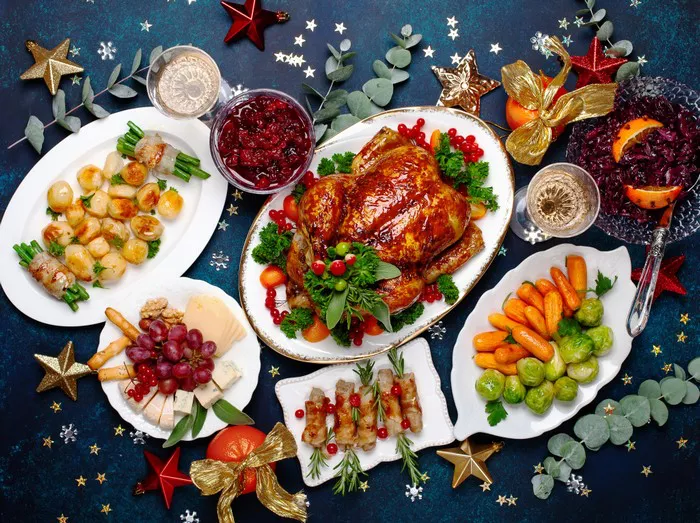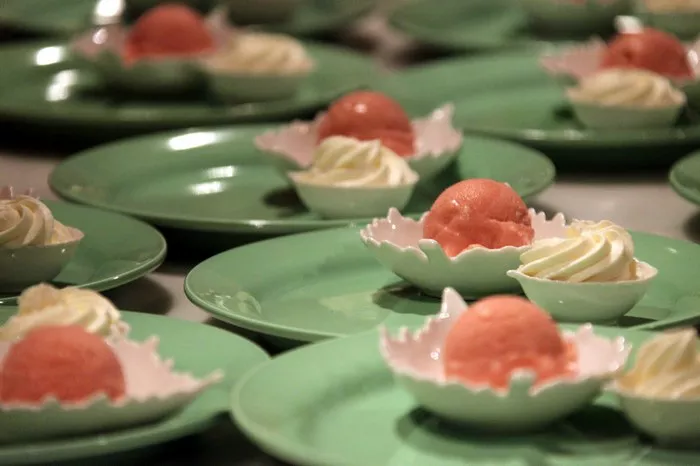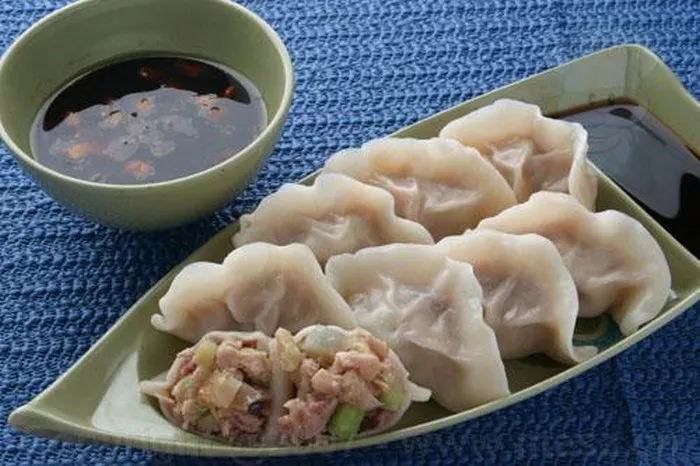Christmas is a time of joy, celebration, and gathering with loved ones. One of the highlights of this festive season is the traditional Christmas dinner, a feast that brings family and friends together around a table adorned with delicious and comforting dishes. But what exactly constitutes a traditional Christmas dinner? Let’s explore the key elements and flavors that make up this cherished culinary tradition.
The Main Star: Roast Turkey
When it comes to a traditional Christmas dinner, the roast turkey takes center stage as the star of the show. This grand bird, with its golden-brown skin and succulent meat, symbolizes abundance and is often the highlight of the holiday table.
The turkey is typically seasoned with a combination of herbs such as thyme, rosemary, and sage, then roasted to perfection. The result is tender, juicy meat that is eagerly anticipated by all. The turkey is often accompanied by rich pan gravy made from the drippings, adding depth and flavor to the meal.
Traditional Accompaniments
Alongside the roast turkey, a variety of classic side dishes are served, adding depth and variety to the Christmas dinner experience. Here are some traditional accompaniments that make a festive appearance:
Stuffing
A flavorful mixture of breadcrumbs, herbs, onions, and sometimes sausage or chestnuts, stuffing is a staple on the Christmas table. It is often cooked inside the turkey, absorbing the delicious juices as it bakes. Variations include sage and onion stuffing, chestnut stuffing, or cranberry stuffing, offering different flavors and textures.
Roast Potatoes
Golden and crispy on the outside, soft and fluffy on the inside, roast potatoes are a beloved side dish. The potatoes are typically parboiled, then roasted in hot fat or oil until they develop a satisfying crunch. They provide a hearty and comforting element to the meal.
Brussels Sprouts
Despite their polarizing reputation, Brussels sprouts are a traditional vegetable that often makes an appearance at Christmas dinners. These small, cabbage-like greens are typically boiled or roasted and served as a flavorful and nutritious side dish.
Carrots and Parsnips
Roasted or glazed carrots and parsnips add sweetness and vibrant color to the holiday spread. The vegetables are often drizzled with honey or maple syrup and roasted until caramelized, creating a delightful balance of flavors.
Cranberry Sauce
Tangy and sweet, cranberry sauce provides a burst of flavor that complements the rich and savory elements of the meal. Made from fresh cranberries, sugar, and often a hint of citrus, this condiment adds a festive touch to the plate.
Yorkshire Puddings
A classic addition to a Christmas dinner in the United Kingdom, Yorkshire puddings are light and airy, resembling a crispy, hollow pastry. They are traditionally served with roast beef, but many families incorporate them into their Christmas feast alongside the turkey for an extra touch of indulgence.
These traditional accompaniments create a harmonious balance of flavors, textures, and colors that enhance the overall Christmas dinner experience.
Decadent Desserts
No Christmas dinner is complete without a selection of decadent desserts to indulge in. Here are some beloved sweet treats that often grace the dessert table:
Christmas Pudding
A quintessential part of the British Christmas tradition, Christmas pudding is a dense, moist, and heavily spiced fruitcake. Made with ingredients like dried fruits, suet, breadcrumbs, and a variety of spices, it is often soaked in alcohol and set alight just before serving. Christmas pudding is typically served with a rich brandy or rum sauce, creating a delightful and festive finale to the meal.
Mince Pies
These bite-sized treats consist of a buttery pastry shell filled with a sweet and aromatic mixture known as mincemeat. Contrary to the name, mincemeat is a combination of dried fruits, spices, sugar, and sometimes a splash of brandy or rum. Mince pies are often served warm or at room temperature and are a popular Christmas treat in the United Kingdom.
Yule Log
Also known as Buche de Noel, the Yule log is a festive dessert inspired by the tradition of burning a log in the hearth. It is a rolled sponge cake filled with cream or buttercream and often decorated to resemble a log. The cake is a visual representation of the Yule log and adds a whimsical touch to the dessert spread.
Trifle
Trifle is a layered dessert that combines sponge cake, fruit, custard, and whipped cream. The layers can be customized with various fruits, such as berries or sliced peaches, and soaked in sherry or fruit juice. Trifle is a refreshing and indulgent option that offers a delightful contrast to the richness of the main course.
These desserts embody the spirit of indulgence and are often enjoyed alongside a cup of coffee or a glass of dessert wine, creating a sweet ending to the Christmas dinner.
Regional Variations
While the aforementioned elements represent a traditional Christmas dinner, it’s important to note that culinary traditions vary across regions and cultures. In different countries and households, variations in main courses, sides, and desserts may reflect local customs and family traditions.
For instance, in the United States, glazed ham or prime rib may be served as an alternative to turkey. In Italy, a Christmas Eve feast known as the Feast of the Seven Fishes is a common tradition, featuring an array of seafood dishes. In Scandinavia, a smorgasbord of pickled herring, meatballs, and other delicacies is enjoyed during the holiday season. These regional variations contribute to the rich tapestry of culinary traditions that make Christmas dinners unique and diverse.
Tips for a Successful Christmas Dinner
Preparing a Christmas dinner can be a delightful and fulfilling experience, but it can also be overwhelming without proper planning. To ensure a successful and enjoyable holiday meal, consider the following tips:
Plan Ahead
Start planning your Christmas dinner well in advance. Create a menu, make a shopping list, and schedule your cooking and preparation tasks. This will help you stay organized and reduce last-minute stress.
Delegate and Collaborate
Don’t be afraid to ask for help from family members or friends attending the dinner. Assign specific tasks such as setting the table, chopping vegetables, or preparing appetizers. Cooking together can be a fun and bonding experience that adds to the festive atmosphere.
Timing Is Key
Create a timeline for your cooking activities to ensure that all dishes are ready at the desired serving time. Consider the cooking times for each component of the meal and plan accordingly. Start with dishes that can be prepared in advance or require less time to cook.
Make a Checklist
Create a checklist to ensure that you have all the necessary ingredients and kitchen tools. Check off items as you gather them, so you can easily keep track of what you have and what you still need to acquire.
Simplify the Menu
While it’s tempting to create an extravagant feast, it’s important to consider your limitations and time constraints. Choose dishes that can be prepared without overwhelming yourself. Focus on a few standout dishes rather than trying to cook an extensive array of recipes.
Embrace Make-Ahead Options
Look for recipes that can be prepared in advance and require minimal last-minute effort. This will allow you to spend more time with your loved ones and minimize stress on the day of the dinner.
Consider Dietary Restrictions
Take into account any dietary restrictions or allergies of your guests when planning the menu. Offer alternative options or modifications to accommodate their needs. Communicate with your guests in advance to ensure everyone can enjoy the meal without any concerns.
Enhance Festive Decor
Pay attention to the table setting and decorations to create a festive ambiance. Use Christmas-themed tablecloths, napkins, and centerpieces to set the mood. Add candles or string lights for a warm and cozy atmosphere.
Remember the Drinks
Prepare a selection of beverages to accompany the meal. Offer options such as wine, champagne, non-alcoholic mocktails, or a signature Christmas punch. Ensure you have enough glasses and ice to cater to your guests’ preferences.
Enjoy the Celebration
Once everything is in motion, take a moment to relax and enjoy the celebration. Remember that the purpose of Christmas dinner is to gather with loved ones, share a meal, and create lasting memories. Don’t let stress overshadow the joyous atmosphere.
By following these tips, you can ensure a successful and stress-free Christmas dinner that allows you to focus on what truly matters—cherishing time with your loved ones and celebrating the holiday spirit.
Creating Lasting Memories
Preparing and enjoying a traditional Christmas dinner is about more than just the food itself. It is an opportunity to come together, express love and gratitude, and create lasting memories with loved ones. The shared experience of savoring the festive flavors, laughing, and enjoying each other’s company is what truly makes a Christmas dinner special.
As you gather around the table this Christmas, take a moment to appreciate the traditions and flavors that have been passed down through generations. Embrace the joy of culinary creation and the warmth of togetherness, knowing that you are participating in a time-honored celebration of love and community.
From the roast turkey to the delectable desserts, a traditional Christmas dinner is a feast for the senses and a celebration of the season. May your Christmas be filled with delicious food, laughter, and cherished moments that will be remembered for years to come.























